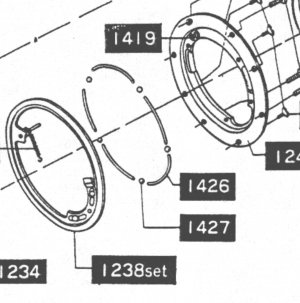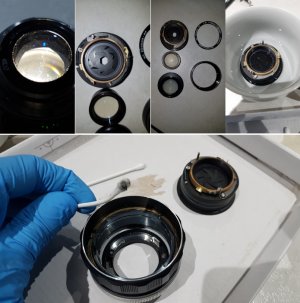KoNickon
Nick Merritt
I had this lens sitting around for years -- never worked. Can't recall when I got it, but the aperture blades were always stuck. I thought I'd give it a go -- found a video that walked me through it. I managed to take it down to the aperture mechanism; removing the optical blocks was very easy once the name ring budged, very reluctantly. Flooding the aperture mechanism freed the aperture blades up. Great!
But in putting it back together I realized the lens had to have been cobbled together and it can't work as configured. The chromed back plate (with the lens mount) has 8 (!) slotted screws that have to be removed (or so I thought) -- four of them are long; four are short. I realized the long screws are to mount the rear assembly that couples the aperture to the camera onto the lens. The short screws are to keep the two plates forming the aperture coupling assembly together.*
So the lens itself has four screw holes for the longer screws, makes sense. They are oriented at top dead center (the focus/aperture index on the lens front), and 3:00, 6:00 and 9:00. The holes on the rear plate for the shorter screws are in between those for the longer screws. This means the rear assembly can only attach to the lens one way. Makes life easy -- except that the back plate on this lens seems to be drilled wrong: The holes for the short screws should be for the long screws, and vice versa. The aperture coupling only works when the rear assembly is positioned so that the short screws are at 12, 3, 6 and 9.
This can't be right, and yet there it is. I could not see how to mount the rear assembly onto the lens based on the screw configuration. Anyone have any thoughts about this? I've buttoned the lens up and put it back in the drawer. At least the aperture works now....
*Before I even got to cleaning the aperture blades I made a bad misstep by unscrewing all the screws. I should have left the short ones alone. As it happened, the rear aperture assembly separated and lots of small parts came out. I was astonished -- 5 miniscule ball bearings, probably 1mm in diameter. And 5 short curved wire pieces. I worked out that they were spacers for the rotating part of the assembly, and the bearings rode in the track between the spacers. (There must have been 6 of the spacers, since there were 5 bearings, but I thought I counted 5. Whatever.) Whether these bearings and spacers were really necessary, I can't say; seems overengineered to me. But at least I didn't lose any of them.
But in putting it back together I realized the lens had to have been cobbled together and it can't work as configured. The chromed back plate (with the lens mount) has 8 (!) slotted screws that have to be removed (or so I thought) -- four of them are long; four are short. I realized the long screws are to mount the rear assembly that couples the aperture to the camera onto the lens. The short screws are to keep the two plates forming the aperture coupling assembly together.*
So the lens itself has four screw holes for the longer screws, makes sense. They are oriented at top dead center (the focus/aperture index on the lens front), and 3:00, 6:00 and 9:00. The holes on the rear plate for the shorter screws are in between those for the longer screws. This means the rear assembly can only attach to the lens one way. Makes life easy -- except that the back plate on this lens seems to be drilled wrong: The holes for the short screws should be for the long screws, and vice versa. The aperture coupling only works when the rear assembly is positioned so that the short screws are at 12, 3, 6 and 9.
This can't be right, and yet there it is. I could not see how to mount the rear assembly onto the lens based on the screw configuration. Anyone have any thoughts about this? I've buttoned the lens up and put it back in the drawer. At least the aperture works now....
*Before I even got to cleaning the aperture blades I made a bad misstep by unscrewing all the screws. I should have left the short ones alone. As it happened, the rear aperture assembly separated and lots of small parts came out. I was astonished -- 5 miniscule ball bearings, probably 1mm in diameter. And 5 short curved wire pieces. I worked out that they were spacers for the rotating part of the assembly, and the bearings rode in the track between the spacers. (There must have been 6 of the spacers, since there were 5 bearings, but I thought I counted 5. Whatever.) Whether these bearings and spacers were really necessary, I can't say; seems overengineered to me. But at least I didn't lose any of them.





